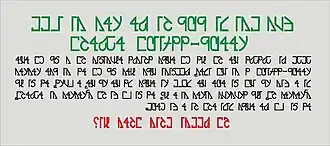Oduduwa script
The Oduduwa script was discovered in 2016 by a Beninese Yoruba chief named Tolúlàṣẹ Ògúntósìn through the directive of Ifa Oracle. The script is used for the Yoruba language of Nigeria and Benin. Ògúntósìn believes that the script was revealed to him by the Yoruba mythic ancestor Oduduwa in a series of dreams from 2011 to 2016.[1] It has received support from other chiefs of Yorubaland in both countries as an adjunct to or possible replacement of the Latin script.[1][2]
| Odùduwà Alifabeeti Oduduwa | |
|---|---|
 | |
| Script type | |
Time period | 2017–present |
| Direction | right-to-left |
| Languages | Yoruba |
 | |
Yoruba has two Latin alphabets, one used in Nigeria and one in Benin.[3] The Oduduwa script is also alphabetic, and is inspired by Latin orthography (e.g. /k͜p/ is written as a single letter, but /ɡ͜b/ as a digraph of the letters for /ɡ/ and /b/, paralleling the Nigerian Yoruba alphabet; similarly, the letters for ⟨ẹ, ọ, ṣ⟩ are derived from those for ⟨e, o, s⟩, and nasal vowels are written with the letter for ⟨n⟩). Oduduwa differs from Latin in being written right-to-left.[1]
The Oduduwa script is being taught to children at schools in Porto-Novo, Benin[4] and in Ifẹ, Nigeria.[5]
Ligatures

Adjacent letters form ligatures: when one letter ends in a long vertical stroke (i.e. ⟨![]() ⟩ d, ⟨
⟩ d, ⟨![]() ⟩ e, ⟨
⟩ e, ⟨![]() ⟩ h, ⟨
⟩ h, ⟨![]() ⟩ i, ⟨
⟩ i, ⟨![]() ⟩ m, ⟨
⟩ m, ⟨![]() ⟩ n, ⟨
⟩ n, ⟨![]() ⟩ o) and the next begins with a such a stroke (i.e. ⟨
⟩ o) and the next begins with a such a stroke (i.e. ⟨![]() ⟩ b, ⟨
⟩ b, ⟨![]() ⟩ ẹ, ⟨
⟩ ẹ, ⟨![]() ⟩ l, ⟨
⟩ l, ⟨![]() ⟩ ọ, ⟨
⟩ ọ, ⟨![]() ⟩ r, ⟨
⟩ r, ⟨![]() ⟩ u, ⟨
⟩ u, ⟨![]() ⟩ w), the two lines are conflated into a single stroke, joining the letters. This occurs for example in the sequence du in the name Oduduwa (see info box above). Where a horizontal line meets another (as in ⟨
⟩ w), the two lines are conflated into a single stroke, joining the letters. This occurs for example in the sequence du in the name Oduduwa (see info box above). Where a horizontal line meets another (as in ⟨![]() ⟩ w and ⟨
⟩ w and ⟨![]() ⟩ a), or with a sharp angle (as in ⟨
⟩ a), or with a sharp angle (as in ⟨![]() ⟩ n and ⟨
⟩ n and ⟨![]() ⟩ i), they may also join; thus iwe forms a double ligature (see image at right). Where letters do not touch, as in ⟨
⟩ i), they may also join; thus iwe forms a double ligature (see image at right). Where letters do not touch, as in ⟨![]() ⟩ t and ⟨
⟩ t and ⟨![]() ⟩ i, they may kern together so that part of one tucks under the other. The comma also connects to letters such as n and i that have a terminal vertical stroke.[1][6]
⟩ i, they may kern together so that part of one tucks under the other. The comma also connects to letters such as n and i that have a terminal vertical stroke.[1][6]
Digits
There is a series of ten digits for writing decimal numbers, which derive from the Hindu-Arabic numerals (and which are also written right-to-left), and basic punctuation (. , : ; - ? apostrophe and quotation marks). Tone is not marked.[1]
Gallery
Letters
 a
a e
e b
b j
j o
o gb
gb d
d f
f t
t ẹ
ẹ ọ
ọ l
l w
w u
u m
m n
n i
i h
h r
r s
s ṣ
ṣ k
k g
g y
y p
p
Digits
 0
0 1
1 2
2 3
3 4
4 5
5 6
6 7
7 8
8 9
9
Punctuation
 hyphen
hyphen question mark
question mark
References
- Adéṣínà Ọmọ Yoòbá (10 March 2020). "This chief hopes Yorùbá speakers adopt his newly invented 'talking alphabet'". Global Voices. Retrieved 4 April 2021.
- "Yoruba Monarchs Commends New Oduduwa Alphabets, Hail Aregbesola". OsunDefender. 1 November 2017.
- Hartell, Rhonda L. (1993). "Benin: Yoruba". Alphabets of Africa. Dakar: UNESCO Regional Office. p. 37.
- "Oduduwa Alphabet: Òmìnira èdè ti dé fún Port Novo báyìí". BBC Yoruba. 15 December 2020 [15 April 2019].
- "Oduduwa alphabets: Ǹjẹ́ ó mọ̀ nípa Álífábẹ́ẹ̀tì Oduduwa àti bí o ṣe lè lòó fi gbé èdè Yorùbá ga?". BBC Yoruba. 17 April 2022.
- non-Unicode fonts and experimental keyboard at World Scripts Explorer